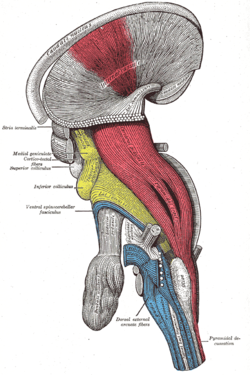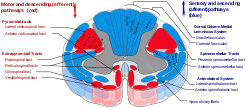Pyramidal tracts
| Corticospinal tract | |
|---|---|
 Deep dissection of brain-stem. Lateral view. ("pyramidal tract" visible in red, and "pyramidal decussation" labeled at lower right.) | |
 Spinal cord tracts, with pyramidal tracts labeled at upper left | |
| Details | |
| Identifiers | |
| Latin | tractus corticospinalis |
| MeSH | D011712 |
| NeuroNames | 1320 |
| NeuroLex ID | birnlex_1464 |
| TA98 | A14.1.04.102 A14.1.06.102 |
| TA2 | 6040 |
| FMA | 72634 |
| Anatomical terms of neuroanatomy | |
The pyramidal tracts refer to both the corticospinal and corticobulbar tracts. These are aggregations of upper motor neuron nerve fibres that travel from the cerebral cortex and terminate either in the brainstem (corticobulbar) or spinal cord (corticospinal)
The corticobulbar tract conducts impulses from the brain to the cranial nerves.[1] These nerves control the muscles of the face and neck and are involved in facial expression, mastication, swallowing, and other functions.
The corticospinal tract conducts impulses from the brain to the spinal cord. It is made up of a lateral and anterior tract. The corticospinal tract is involved in voluntary movement. The majority fibres of the corticospinal tract cross over in the medulla, resulting in muscles being controlled by the opposite side of the brain. The corticospinal tract also contains betz cells (the largest pyramidal cells), which are not found in any other region of the body.
The pyramidal tracts are named because they pass through the pyramids of the medulla.
Structure
The pyramidal tracts refer to upper motor neurons that originate in the cerebral cortex and terminate in the spinal cord (corticospinal) or brainstem (corticobulbar). Nerves emerge in the cerebral cortex, pass down and may cross sides in the medulla, and travel as part of the spinal cord until they synapse with interneurons in the middle part of the spinal cord, known as grey matter.[2]
There is some variation in terminology. The pyramidal tracts definitively encompass the corticospinal tracts. Many, but not all authors also consider the tracts to include the corticobulbar tract.[3]
Corticospinal tract
Nerve fibres in the corticospinal tract originate from from pyramidal cells in layer V of the cerebral cortex. Fibres arise from the primary motor cortex (about 30%), supplementary motor area and the premotor cortex (together also about 30%), and the somatosensory cortex, parietal lobe, and cingulate gyrus supplies the rest.[2] These fibres travel from the cortex through the posterior limb of internal capsule and into the brainstem and medulla. Here they form two prominences called the pyramids of the medulla. Below the prominences, the majority of fibres cross over to the opposite side from which they originated. The fibres that cross over form the lateral corticospinal tract, whereas the fibres that do not form the anterior corticospinal tract [2] About 80% of fibres cross over and form the lateral corticospinal tract; 10% do not cross over and join the tract, and 10% of fibres travel in the anterior corticospinal tract. [citation needed]
The nerve fibres travelling down the tract are referred to as upper motor neurons. In the spinal cord, the axons of the upper motor neuron synpase with lower motor neurons. The majority of nerve fibres do not directly synpase with lower motor neurons, but instead synapse with an interneuron that then synapses with a lower motor neuron. This generally occurs in the anterior horn of the spinal cord [2]
The average fiber diameter is in the region of 10μm; around 3% of fibres are extra-large (20μm) and arise from Betz cells, mostly in the leg area of the primary motor cortex.

Corticobulbar tract
Fibres from the wikt:ventral motor cortex travel with the corticospinal tract through the internal capsule, but terminate in a number of locations in the midbrain (cortico-mesencephalic tract), pons (Corticopontine tract), and medulla oblongata (cortico-bulbar tract). [4] The upper motor neurons of the corticobulbar tract synapse with interneurons or directly with the lower motor neurons located in the motor cranial nerve nuclei, namely oculomotor, trochlear, motor nucleus of the trigeminal nerve, abducens, facial nerve and accessory and in the nucleus ambiguus to the hypoglossal, vaguss and accessory nerves. [4] These nuclei are supplied by nerves from both sides of the brain, with the exception of the parts of the facial nerve that control muscles of the lower face. These muscles are only innervated by nerves from the same side of the brain. [4]
Function
The nerves within the corticospinal tract are involved in movement of muscles of the body. Because of the crossing-over of fibres, muscles are supplied by the side of the brain opposite to that of the muscle. [2] The nerves within the corticobulbar tract are involved in movement in muscles of the head. They are involved in swallowing, phonation, and movements of the tongue. [4] By virtue of involvment with the facial nerve, the corticobulbar tract is also responsible for transmitting facial expression. [5] With the exception of lower muscles of facial expression, all functions of the corticobulbar tract involve inputs from both sides of the brain. [5]
The term extrapyramidal motor system is used to refer to tracts within the spinal cord involved in voluntary movement but not part of the pyramidal tracts. [2] Their functions include voluntary movement, control posture and muscle tone.[citation needed]
Clinical significance
Damage
Damage to the descending motor pathways anywhere along the trajectory from the cerebral cortex to the lower end of the spinal cord gives rise to a set of symptoms called the "Upper Motor Neuron Syndrome". A few days after the injury to the upper motor neurons, a pattern of motor signs and symptoms appears, including spasticity, increased vigor (and decreased threshold) of deep tendon reflexes, a loss of the ability to perform fine movements, and an extensor plantar response known as the Babinski sign.[6]
Additional images
-
Dissection of brain-stem. Lateral view.
-
Superficial dissection of brain-stem. Ventral view.
-
The motor tract.
-
Diagram of the principal fasciculi of the spinal cord, from Gray's anatomy
References
- ^ Chapter 9 of "Principles of Physiology" (3rd edition) by Robert M. Berne and Mathew N. Levy. Published by Mosby, Inc. (2000) ISBN 0-323-00813-5.
- ^ a b c d e f Hall, Arthur C. Guyton, John E. (2005). Textbook of medical physiology (11th ed. ed.). Philadelphia: W.B. Saunders. pp. 687–690. ISBN 978-0-7216-0240-0.
{{cite book}}:|edition=has extra text (help)CS1 maint: multiple names: authors list (link) - ^ Anthoney, Terence R. (1994). Neuroanatomy and the neurologic exam : a thesaurus of synonyms, similar-sounding non-synonyms, and terms of variable meaning. Boca Raton: CRC Press. pp. 458–460. ISBN 9780849386312.
- ^ a b c d Young, Paul A. (2007). Basic clinical neuroscience (2nd ed. ed.). Philadelphia, Pa.: Lippincott Williams & Wilkins. pp. 69–70. ISBN 9780781753197.
{{cite book}}:|edition=has extra text (help) - ^ a b Arslan, Orhan (2001). Neuroanatomical Basis of Clinical Neurology. CRC Press. p. 368. ISBN 1439806136.
- ^ http://www.ncbi.nlm.nih.gov/bookshelf/br.fcgi?book=neurosci&part=A1191
External links
- . GPnotebook https://www.gpnotebook.co.uk/simplepage.cfm?ID=959774759.
{{cite web}}: Missing or empty|title=(help) - McGill
- Stained brain slice images which include the "Corticospinal tract" at the BrainMaps project





